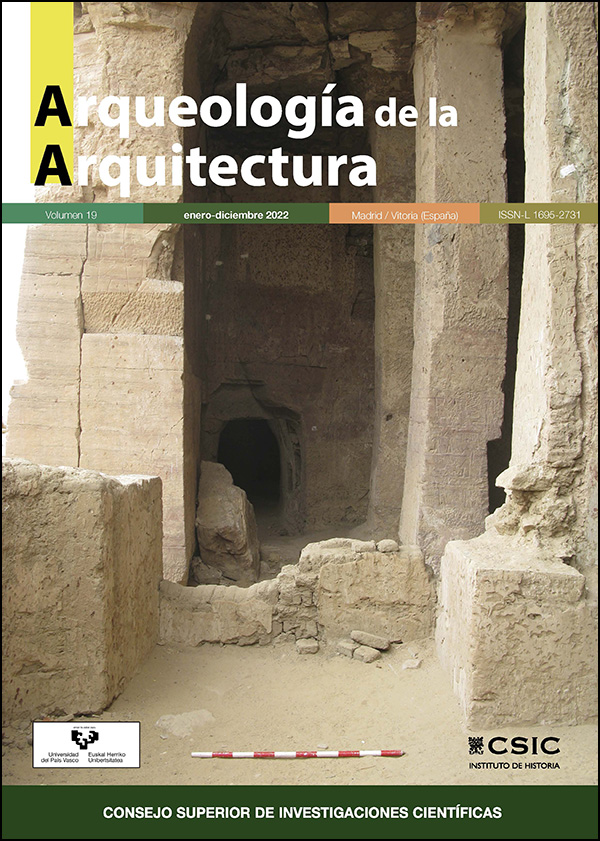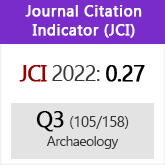El consumo de agua en la construcción romana con morteros de cal: un método de cálculo
DOI:
https://doi.org/10.3989/arq.arqt.2022.008Palabras clave:
construcción en la Antigüedad, mortero de cal, hormigón romano, economía de la construcción, consumo de aguaResumen
Los hormigones romanos son una de las áreas de la construcción en la Antigüedad que han atraído más atención. Muchos estudios se han dedicado a las propiedades técnicas y químicas de este hormigón y a la economía de la industria de la construcción romana. En estos estudios, siempre se señala el papel del agua como importante y se indica que se consumía en grandes cantidades. Y aunque se han realizado cálculos para determinar las cantidades de horas de trabajo, de cal, piedra, madera y otros materiales, no ha habido estudios semejantes para calcular los volúmenes de agua necesarios. En este artículo, propongo una serie de ratios -derivadas de las fuentes escritas, recomendaciones modernas y análisis científicos, contrastadas con resultados experimentales- con las cuales llegar a una aproximación a los volúmenes de agua necesarios en las construcciones en mortero romanas. Esto será una útil estimación para futuros estudios sobre las practicidades y las economías de la construcción en mortero en la Antigüedad.
Descargas
Citas
Adam, J.-P. 1994 [1989]: Roman Building. Materials and Techniques. Batsford, London.
Berry, J. 1997: "The conditions of domestic life in Pompeii in AD 79: a case-study of Houses 11 and 12, Insula 9, Region I", Papers of the British School at Rome, 65, pp. 103-125. https://doi.org/10.1017/S0068246200010606
Bonen, D., Tasdemir, M., and Sarkar, S. 1994: "The evolution of cementitious materials through history", Material Research Society Symposium Proceedings, 370, pp. 159-168. https://doi.org/10.1557/PROC-370-159
Brune, P. 2010: The Mechanics of Imperial Roman Concrete and the Structural Design of Vaulted Monuments. Doctoral dissertation, Universidad de Rochester.
Brune, P., Perucchio, R., Ingraffea, A., and Jackson, M. 2010: "The toughness of imperial Roman concrete", in B. H. Oh, O. C. Choi, and L. Chung (eds.), Fracture Mechanics of Concrete and Concrete Structures: Recent Advances in Fracture Mechanics of Concrete, pp. 38-45. Korea Concrete Institute, Seoul.
Bukhari, S., McElligott, A., and Parkes, R. 2021: "Quantifying the impact of mounted load carrying on equids", Animals, 5, pp. 1-14. https://doi.org/10.3390/ani11051333 PMid:34067208 PMCid:PMC8151148
Camporeale, S. 2010: "Military building techniques in Mauretania Tingitana: the use of mortar and rubble at Thamusida (Sidi Ali ben Ahmed, Morocco)", in Å. Ringbom, and R. L. Hohlfelder (eds.), Building Roma Aeterna: Current Research on Roman Mortar and Concrete. Commentationes Humanarum Litterarum 128, pp. 169-186. Societas Scientiarum Fennica, Helsinki.
Cazalla Vázquez, O. 2002: Morteros de cal. Aplicación en el patrimonio histórico. Doctoral dissertation, Universidad de Granada.
Dapena García, J. E. 2009: Materiales pétreos de construcción. Escuela Universitaria de Ingeniería Técnica de Obras Públicas, Madrid.
DeLaine, J. 1997: The Baths of Caracalla: a Study in the Design, Construction and Economics of Large-Scale Building Projects in Imperial Rome. JRA supplement series 25. Journal of Roman Archaeology, Portsmouth.
DeLaine, J. 2017: "Quantifying manpower and the cost of construction in Roman building projects: research perspectives", Archeologia dell'Architettura, 22, pp. 13-19.
Dix, B. 1982: "The manufacture of lime and its uses in the Western Roman provinces", Oxford Journal of Archaeology, 1.3, pp. 331-346. https://doi.org/10.1111/j.1468-0092.1982.tb00318.x
Gárate, I. 2002: Artes de la cal. Instituto Español de Arquitectura, Madrid.
Goldsworthy, H., and Zhu, M. 2009: "Mortar studies towards the replication of Roman concrete", Archaeometry, 51.6, pp. 932-946. https://doi.org/10.1111/j.1475-4754.2009.00450.x
Gros, P. 2013: "L'opus signinum selon Vitruve et dans la terminologie archéologique contemporaine", in P. Gros (ed.), Vitruve et la tradition des traités d'Architecture. Cóllection de l'École Française de Rome 366, pp. 473-484. Académie de France à Rome, Rome. https://doi.org/10.4000/books.efr.2522
Harper, E. 1934: "Lime slaking", Journal of the American Water Works Association, 26.6, pp. 750-756. https://doi.org/10.1002/j.1551-8833.1934.tb19413.x
Henning, J., McCormick, M., Olmo Enciso, L., Rassman, K., and Fikrit, E. 2019: "Reccopolis revealed: first geomagnetic mapping of the early medieval Visigothic royal town", Antiquity, 93(369), pp. 735-751. https://doi.org/10.15184/aqy.2019.66
Hobbs, L., and Siddall, R. 2010: "Cementitious materials of the Ancient World", in Å. Ringbom and R. Hohlfelder (eds.), Building Roma Aeterna: Current Research on Roman Mortar and Concrete. Commentationes Humanarum Litterarum 128, pp. 35-59. Societas Archeologica Fennica, Helsinki.
Hohfelder, R. L., Brandon, C., and Oleson, J. P. 2007: "Constructing the harbour of Caesarea Palaestina, Israel: new evidence from the ROMACONS field campaign of october 2005", International Journal of Nautical Archaeology, 36.2, pp. 409-415. https://doi.org/10.1111/j.1095-9270.2007.00156.x
Hughes, D., S. Swann, and A. Gardner. 2007: "Roman cement: part two: stucco and decorative elements, a conservation strategy", Journal of Architectural Conservation 13.3, pp. 41-58. https://doi.org/10.1080/13556207.2007.10785008
Jackson, M., and Marra, F. 2006. "Roman stone masonry: volcanic foundations of the Ancient City", American Journal of Archaeology 110.3, pp. 403-436. https://doi.org/10.3764/aja.110.3.403
Jackson, M., Logan, J. M., Scheetz, B. E., Deocampo, D. M., Cawood, C. G., Marra, F., Vitti, M., and Ungaro, L. 2009: "Assessment of material characteristics of ancient concretes, Grande Aula, Markets of Trajan, Rome", Journal of Archaeological Science, 36, pp. 2481-2492. https://doi.org/10.1016/j.jas.2009.07.011
Lancaster, L. 2005: Concrete Vaulted Construction in Imperial Rome. Innovations in Context. Cambridge University Press, Cambridge. https://doi.org/10.1017/CBO9780511610516
Lechtman, H., and Hobbs, L. 1987: "Roman concrete and the Roman architectural revolution", in W. Kingery (ed.), High-Technology Ceramics: Past, Present, and Future-The Nature of Innovation and Change in Ceramic Technology, pp. 81-128. The American Ceramic Society, Westerville.
Lynch, G. 2017. "Hot lime mortars for traditionally constructed brickwork", Building Limes Forum Journal, 27, pp. 38-49.
Margalha, M. G., Santos Silva, A., Veiga, M., Brito, J., Ball, R., and Allen, G. 2013: "Microstructural changes of lime putty during aging", Journal of Materials in Civil Engineering, 25, pp. 1524-1532. https://doi.org/10.1061/(ASCE)MT.1943-5533.0000687
Martínez Jiménez, J. 2015. "A preliminary study on the aqueduct of Reccopolis", Oxford Journal of Archaeology, 34.3, pp. 301-320. https://doi.org/10.1111/ojoa.12060
Martínez Jiménez, J. 2020: "Water in ancient construction", in E. Sánchez López (ed.), The Role of Water in Production Processes in Antiquity, Panel 3.19. Archaeology and Economy in the Ancient World 21, pp. 11-20. Propylaeum, Heidelberg.
Mille, P., and Rollet, P. 2020: "Étude de trois grands tonneaux mis au jour à Reims/Durocortorum (Marne) : le savoir-faire des tonneliers antiques", Gallia, 77.2, pp. 123-155. https://doi.org/10.4000/gallia.5242
Mogetta, M. 2013: The Origins of Concrete in Rome and Pompeii. Doctoral dissertation, Universidad de Michigan.
Mold, P., and Godbey, R. 2005: "Limewash: compatible coverings for masonry and stucco", in International Building Lime Symposium 2005. Orlando, Florida, March 9-11, 2005, pp. 1-11. International Building Lime Symposium, Orlando.
Morgan, G. 1992. Romano-British Plasters and Mortars. Doctoral dissertation, Universidad de Leicester.
Oguz, C., Turker, F., and Kockal, N. U. 2014: "Construction materials used in the historical Roman era bath in Myra", The Scientific World Journal, s/n, pp. 1-9. https://doi.org/10.1155/2014/536105 PMid:25089290 PMCid:PMC4098611
Oleson, J. P. 2010: "Harena sine calce: Building disasters, incompetent architects, and construction fraud in Ancient Rome", in Å. Ringbom, and R. L. Hohlfelder (eds.), Building Roma Aeterna: Current Research on Roman Mortar and Concrete. Commentationes Humanarum Litterarum 128, pp. 9-27. Societas Scientiarum Fennica, Helsinki.
Oleson, J. P., Brandon, C., Cramer, S., Cucitore, R., Gotti, E., and Hohlfelder, R. 2004: "The ROMACONS Project: a contribution to the historical and engineering analysis of hydraulic concrete in Roman maritime structures", International Journal of Nautical Archaeology, 33.2, pp. 199-229. https://doi.org/10.1111/j.1095-9270.2004.00020.x
Pötzl, C., Siegesmund, S., López-Doncel, R., and Dohrmann, R. 2022: "Key parameters of volcanic tuffs used as building stone: a statistical approach", Environmental and Earth Sciences, 81. https://doi.org/10.1007/s12665-022-10530-6
Pozo Antonio, S. 2015: "Evolution of mechanical properties and drying shrinkage in lime-based and lime cement-based mortars with pure limestone aggregate", Construction and Building Materials, 77, pp. 472-78. https://doi.org/10.1016/j.conbuildmat.2014.12.115
Rubio Bardon, C. 2011: "Los materiales de construcción en Los diez libros de arquitectura de Vitruvio", Cahiers des études anciennes, 48, pp. 61-87.
Sánchez López, E., and Martínez Jiménez, J. 2016: Los acueductos de Hispania. Construcción y abandono. Fundación Juanelo Turriano, Madrid.
Sánchez Moral, S., Luque, L., Cañaveras, J. C., Soler, V., García Guinea, J., and Aparicio, A. 2005: "Lime-pozzolana mortars in Roman catacombs: composition, structures and restoration", Cement and Concrete Research, 35.8, pp. 1555-1565. https://doi.org/10.1016/j.cemconres.2004.08.009
Sánchez, J., Barrios, J., Barrios, Á., and de Arellano, A. 1997: "La retracción en los morteros de cal", Materiales de construcción, 47(245), pp. 17-28. https://doi.org/10.3989/mc.1997.v47.i245.511
Sear, F. 2008 [1982]: Roman Architecture. Routledge, Londres.
Serlorenzi, M., and Camporeale, S. 2017: "Anatomia di un muro romano: dati preliminari sullo smontaggio e quantificazione di alcune strutture in laterizio di epoca adrianea dallo scavo di Piazza Dante a Roma", Archeologia dell'Architettura 22, pp. 21-34.
Siddall, R. 2010: "From kitchen to bathhouse: the use of waste ceramics as pozzolanic additives in Roman mortars", in Å. Ringbom, and R. L. Hohlfelder (eds.), Building Roma Aeterna: Current Research on Roman Mortar and Concrete. Commentationes Humanarum Litterarum 128, pp. 152-168. Societas Scientiarum Fennica, Helsinki
Snyder, J. R. 2020: "From forest to trowel: the economics of mortar production in late antiquity" in C. Courault, and C. Márquez (eds.), Quantitative Studies and Production Cost of Roman Public Construction, pp. 471-503. Universidad de Córdoba, Córdoba.
Uğurlu Sağın, E., Engin Duran, H., and Böke, H. 2021: "Lime mortar technology in ancient eastern Roman provinces", Journal of Archaeological Science: Reports 39. https://doi.org/10.1016/j.jasrep.2021.103132
UNILAD, 2021: Making Roman style concrete. [Online content, consulted 11/11/2021].
Van Oyen, A. 2017: "Finding the material in 'material culture'. Form and matter in Roman concrete", in A. Van Oyen and M. Pitts (eds.), Materialising Roman Histories, pp. 133-154. Oxbow, Oxford. https://doi.org/10.2307/j.ctt1v2xtgh
Wright, G. 2005: Ancient Building Technology. Technology and Change in History 7.1. Brill, Leiden
Publicado
Cómo citar
Número
Sección
Licencia
Derechos de autor 2022 Consejo Superior de Investigaciones Científicas (CSIC) - Universidad del País Vasco/Euskal Herriko Unibertsitatea (UPV/EHU)

Esta obra está bajo una licencia internacional Creative Commons Atribución 4.0.
© CSIC. © UPV/EHU. Los originales publicados en las ediciones impresa y electrónica de esta Revista son propiedad del Consejo Superior de Investigaciones Científicas y de la Universidad del País Vasco/Euskal Herriko Unibertsitatea, siendo necesario citar la procedencia en cualquier reproducción parcial o total.Salvo indicación contraria, todos los contenidos de la edición electrónica se distribuyen bajo una licencia de uso y distribución “Creative Commons Reconocimiento 4.0 Internacional ” (CC BY 4.0). Puede consultar desde aquí la versión informativa y el texto legal de la licencia. Esta circunstancia ha de hacerse constar expresamente de esta forma cuando sea necesario.
No se autoriza el depósito en repositorios, páginas web personales o similares de cualquier otra versión distinta a la publicada por el editor.
Datos de los fondos
Ministerio de Ciencia e Innovación
Números de la subvención PID2019.106686GA.I00
Agencia Estatal de Investigación
Números de la subvención PID2019.106686GA.I00
















